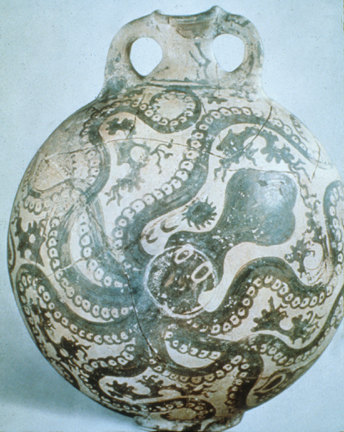
Octopus Flask, Late Minoan, Crete
1580-1100 BCE
ART 198 - HISTORY OF WORLD CERAMICS
| Between 1700-1450 BCE, Minoan influence was widespread throughout the Aegean area, and many of the inhabited islands of the Cyclades and mainland Greece (Mycenae for example) were extensively influenced by Crete. The Minoan culture was named after King Minos of Crete, who ruled around the time of 1350-1250 BCE. Great palaces were built at Knossus and Phaistos, among other locations.This remarkable culture was relatively stable over a period of 1600 years. Its location in the center of the Mediterranean caused it to be a center of trade and oil and wine were exported in pottery vessels in trade for food crops from the mainland. Unlike their contemporaries the Egyptians, there was no oppressive priesthood or rigid artistic styles, and Minoan art reflected a freedom and willingness to assimilate other artistic traditions from throughout the region. Common motifs are creatures of the sea, not surprising since a large part of the commerce and diet of these peoples came from fishing boats that plied the waters of the Mediterranean. Here, in a very representative example, a bold painting of an octopus glides around and covers the surface of this flask. Note how successfully the artist has drawn the suckers on the tentacles, and how the coiling circles of the ends of the tentacles are repeated in the shapes of the handles flanking the spout. The Minoan artist did not constrain the design within banded areas, but rather let the images freely flow around the vessel. | Octopus Flask, Late Minoan, Crete 1580-1100 BCE |
|
|